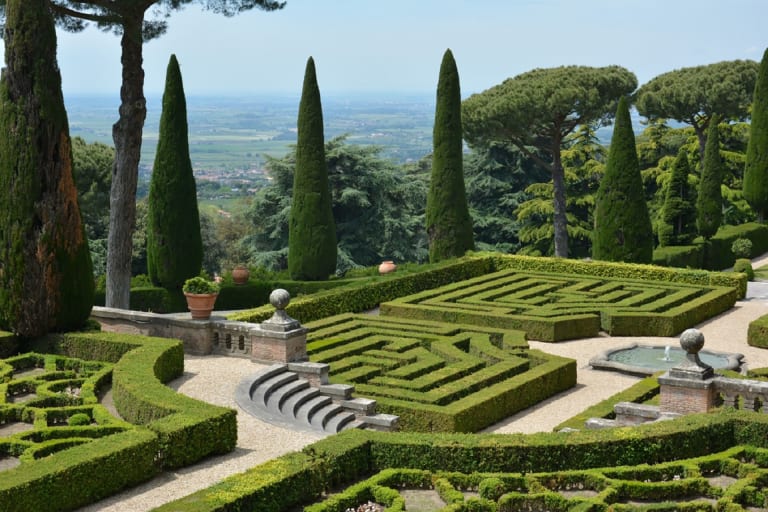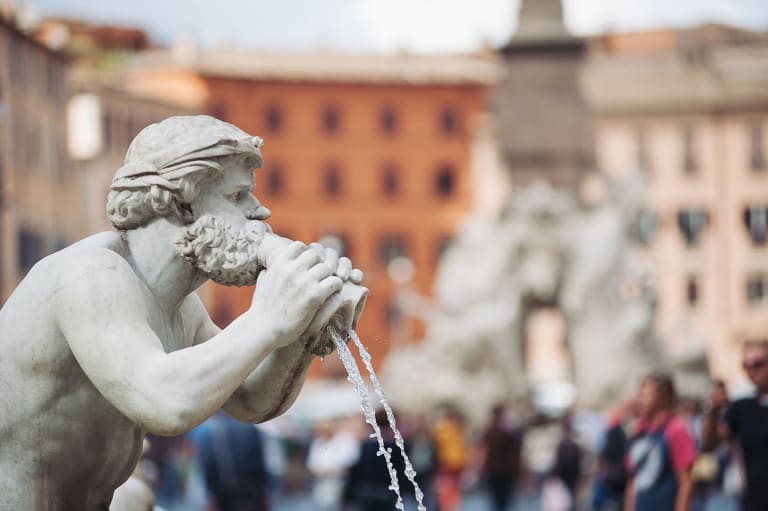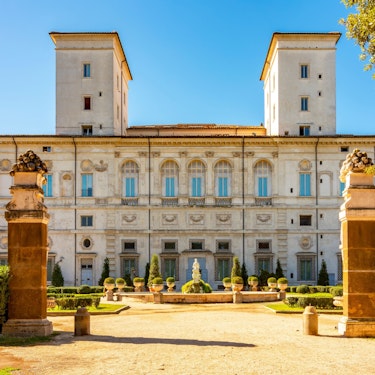More about: Rome Pass
Every traveler seeks to feel free to explore their destination, soak up its culture, know its corners, stories.... But to do so, you have to plan and do the math. Buying the Roma Pass tourist card can be a great help. I'll tell you why.
What is the Roma Pass and how much it costs

Rome has the Roma Pass card, which allows travelers to save time and money during their visit; two very precious commodities when it comes to making the most of a trip. I am going to tell you when and how to use it, as well as help you decide if it is the best option for you depending on what you want to discover about the city.
The price of tourist cards, in general, can be counted in two ways: by the number of days you use it or by the number of tourist attractions you visit with it. In case you decide to buy the Roma Pass it is the first one: its price depends on the number of days you use it for.
Types of Roma Pass

You can book two types of Roma Pass:
Roma Pass 2 days
It is valid for 48 hours after the first use and includes free admission to one monument or museum included in its catalog and 20% discount on the rest of the tourist attractions of the same.
Roma Pass 3 days
Valid for 72 hours after the first use and includes free admission to two monuments or museums included in its catalog and 20% discount on the rest of the tourist attractions of the same.
What does the Roma Pass include?

- Free admission to 1 museum if you choose the 48-hour card and 2 if you choose the 72-hour card. Admission to the Vatican Museums is not included. If you want to have access to the Vatican monuments you have to get this card which also includes the Omnia Card.
- Reduced rate (minimum 20% discount) in the remaining museums and monuments for which you do not use the free admission.
- Discounts on shows, additional tourist services (bicycle rental, tours, tourist bus...) and temporary exhibitions (many of them with skip-the-line access).
- Discounts in archaeological areas that are not directly managed by the Municipality of Rome. This is the case, for example, of Villa Medici or the Circus Maximus.
- Queue-free access to the Colosseum and other points of interest.
- Free access for the duration of the Roma Pass to all public transport in Rome (metro and buses). Airport transfer and regional trains are not included.
- A map and guide to the main points of interest in Rome.
Attractions included in the Roma Pass

If you buy the Roma Pass you will have included:
Colosseum, Forum of Rome and Palatine Hill
These are the three main must-see sites for those interested in Ancient Rome (the Colosseum is the most visited monument in Rome next to the Vatican Museums). Admission to all three is joint and if you want to know more about how to visit them independently, without the need to have the card, you can read these other articles on Colosseum, Roman Forum, and Palatine Hill Guided Tours y Rome Colosseum Tickets And Tours.
Capitoline Museums
They often go unnoticed by visitors to Rome in pursuit of the Vatican Museums, which is a big mistake. These museums located on the Capitoline Hill (Campidoglio) are considered the oldest in the world and house a collection of works of art that includes paintings by Titian, Caravaggio and Rubens, among others.
Sant Angelo Castle
They call it "The guardian of Rome" as it was the fortress that the Romans used to face the constant sieges of the city. Although it was originally conceived as the mausoleum of Emperor Hadrian, it has also served (in addition to being a fortress) as a papal palace and a prison. It is one of the points of interest in which the reduced rate is most rewarding, as it can mean a difference of more than 70% discount compared to the usual price.
Borghese Gallery
One of the most hidden treasures of Rome and probably one of the most enjoyable during your visit because of the low number of visitors compared to other tourist sites. The Borghese Gallery is one of the essential art galleries of Rome and includes inside sculptures of exquisite beauty. Another added value of this enclave is that it is located in the lung of Rome: the Villa Borghese gardens.
Other museums or places of interest
On the official website of the Roma Pass you can check the rest of the points of interest that you can visit with this card, but here are some other museums and monuments included:
- Palazzo Barberini
- Trajan's Market
- National Etruscan Museum of Villa Giulia
- Baths of Diocletian
- Palazzo Massimo alle Terme
- Balbi Crypt
- National Gallery of Modern Art of Rome
- Palazzo Venezia
- Spada Gallery
- Museum of Rome
When is the Roma Pass worth buying?

The big question on your mind is whether it pays to buy a Rome tourist card. Myself, when planning a trip, I always sit down to gather information about the city's tourist cards to answer the same question. To help you avoid this step, I'm going to give you all the information you need to decide whether or not to buy the Roma Pass. Here's what you need to consider:
Number of days you are going to be in Rome
The Roma Pass is subscribed to a period of two or three days, if your intention is to see the city in a short time you will find it very useful, but if you are going to be, for example, 10 days in Rome (unless you dedicate the first few days to do all the sightseeing and then walk around the city at your leisure) may not be worth it because you can only use it during part of your visit.
Discounts you are entitled to based on age and profession
The main advantage of the Roma Pass is the 20% discount on admission to museums and monuments, but perhaps because of your age or profession you already have this discount without the Roma Pass. For example, EU citizens between 18 and 24 years old already have a discount for the Colosseum, so the Roma Pass would not be of any use to them, as the discounts are NOT cumulative.
Waiting time at tourist attractions
Beneficiaries of a Roma Pass card will be able to access the Castel Sant Angelo, the Capitoline Museums and the Colosseum through a special window. That means saving more than considerable waiting time that without the tourist card (unless the tourist attraction in question allows online booking in advance to avoid queues as in the case of the Colosseum) you would have to do.
Monuments and museums you want to visit
You will amortize the Rome tourist pass when you want to visit several places of interest that require entrance; if this is not your case and your plan is to walk the streets of the city, you may not need the pass. If you are interested in visiting any attraction(s), calculate their price separately and compare it with the price of the Roma Pass.
How you will get around Rome
The Roma Pass includes free transportation on the metro and city buses (which, by the way, are not free, although sometimes you may have thought so, as they have a different ticket validation system than in other European cities). If you are staying in the center of Rome and can get around on foot or if you are renting a motorcycle during your stay and will not be using public transportation, this will be a perk of the tourist pass that you will miss out on.
Ana's Traveller Tip
Before visiting any place in Rome always check if they have discounts with the Roma Pass and if you have preferential access for having the card. More than once you will be pleasantly surprised.
How does the Roma Pass work?

If you purchase your Roma Pass card online you will receive instructions on where you can pick it up once you are in Rome with the voucher that will be sent to you after your purchase. Some of these points are:
- The museums and sites included in the card.
- APT tourist information points (also available at airports).
- Several metro stations.
Once you pick up the card, you will have to fill it in with your personal data and the date of use when you will activate it. At the tourist points you will be asked to present the card together with your ID, at the metro stations there is a screen that will read the code of this card and on the bus you just have to carry it with you.
The Roma Pass will be activated the first time you use it (if you arrive in Rome in the afternoon and want to pick it up at the airport, it is not worth using it only for the metro because you will lose hours of use) and remember that in many tourist attractions you will not have to queue at the entrance because you own this card.
Ana's Traveller Tip
If you are visiting the Colosseum, at the entrance there is a queue reserved for the beneficiaries of this card.
Organize your trip with the Roma Pass

The Roma Pass card will make things much easier for you during your visit to Rome, but apart from that I am going to give you some tips to make the most of it (remember that you only have 48 or 72 hours to make the most of it). Before activating your Roma Pass you should take into account:
Opening hours of the attractions
Check the opening hours and days of all the tourist attractions you want to visit. The Colosseum is open all year round, but on Mondays in Rome most museums are closed and some may also be closed on public holidays. Make sure you do not activate your card on a Monday morning if you want to use it to access the Capitolinost Museums or visit Castel Sant Angelo because you will find them closed and you will have wasted valuable time on your card.
Plan your visits in advance
The aim is that you will be able to see most of the sites that require entrance tickets during the time you enjoy the Roma Pass, so it is important that you decide the order in which you will see the museums according to their opening hours. Keep in mind that to visit the Colosseum and the Roman Forum you will need a whole morning. Most museums usually close at 19:30 in Rome.
Check how long it takes to get from one attraction to another
In Rome most places are accessible on foot, but there are some places like Villa Borghese or the Vatican City that are more remote and can take longer to reach.
If you are traveling with children
If you are traveling with children it is not advisable to get the Roma Pass for them as they will get free entry to most of the tourist sites in the city. In fact, I would recommend that you don't take it out for yourself either in this case as if you want to make the most of it going from one place to another the kids might not be able to keep up with the pace.
About public transportation in Rome
The Roma Pass includes public transportation for free, but I will tell you that in Rome the waiting times for the bus can be long, so if you can walk from one place to another I recommend it. Therefore, it is best to organize visits to monuments or museums that are within the same area.
What other tourist passes are there to visit Rome?

Omnia Card
So far I have told you about the advantages of the Roma Pass, as it is one of the main passes in the city. However, you will have seen that there are areas of the Vatican such as the Vatican Museums that are not included: for them there is the Omnia Card. This card guarantees free and fast access to the Vatican Museums, preferential entrance with audio guide to St. Peter's Basilica and discounts in different Museums and areas of the Vatican.
Now you may be wondering: "Which one should I choose? That's the best part: you don't have to choose because the Omnia Card includes the Roma Pass so you can spend two (or three) days visiting Rome and one day in the Vatican City area. Unless you have already visited the Vatican on a previous trip, this is definitely the option I recommend: combine both cards.
Anyway, I recommend you to read this other article I made about Rome Omnia Card to clear all your doubts if you still have them.
If you are interested in the Roma Pass you will also be interested in
If you have decided for the Roma Pass and you are going to visit the Colosseum, the Capitoline Museums, the Borghese Gallery and Castel Sant Angelo, you surely don't want to miss one of the main options not included in this tourist pass: the Vatican Museums. If using the Omnia Card together with the Roma Pass doesn't work for you, you can use your Roma Pass for all the monuments and museums included and then buy tickets for the Vatican on your own. I tell you how to do it in this article on Vatican Tickets and Tours.
If you still prefer to buy the tickets separately, for example for the Colosseum, I leave you here linked my article on Rome Colosseum Tickets And Tours.
There is also the possibility of buying a combined ticket for the Colosseum and the Vatican Museums, which also includes a guided tour of both sites. I leave you here all the information: Vatican and Colosseum Combo Tickets in Rome.
















